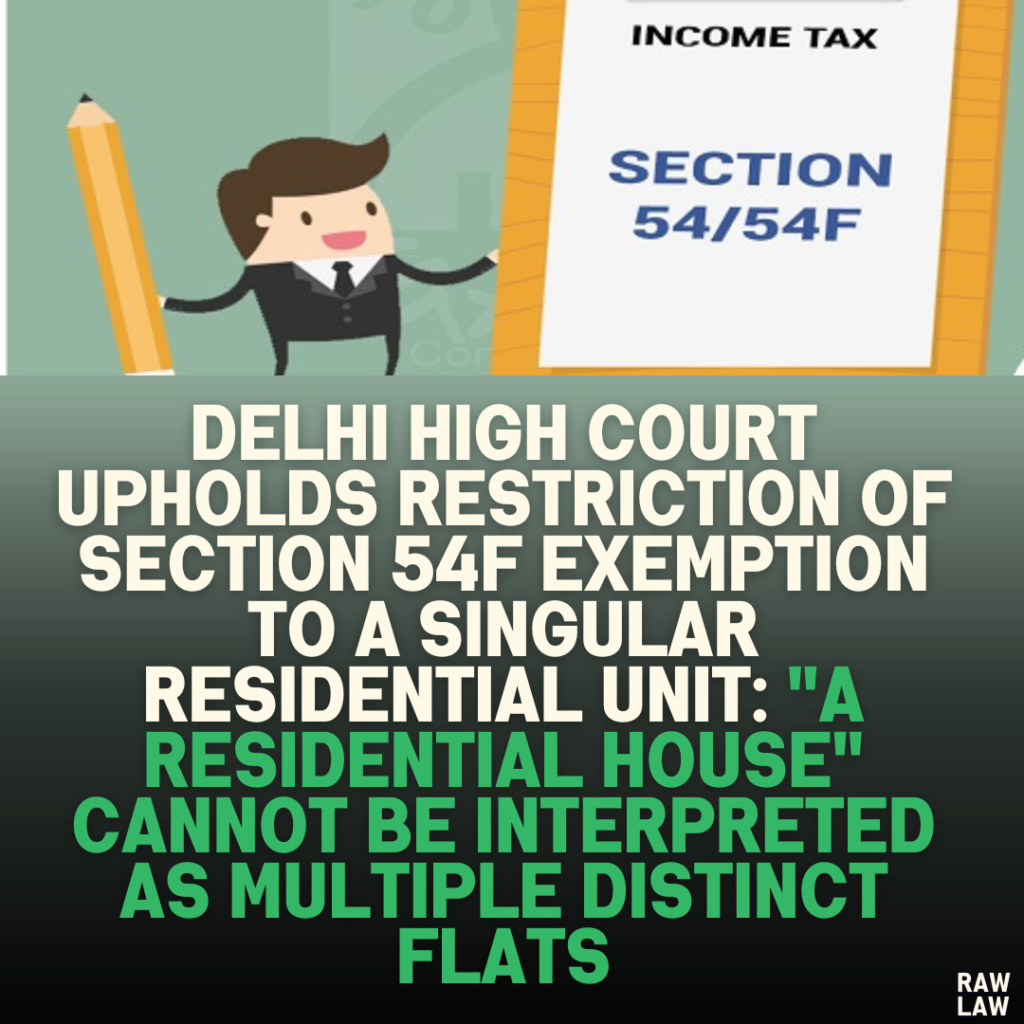Court’s Decision
The Delhi High Court held that under Section 54F of the Income Tax Act, 1961, the term “a residential house” must be interpreted in a singular sense, thereby limiting the benefit to a single residential unit. The Court dismissed the appeal by the assessee, confirming the Income Tax Appellate Tribunal’s (ITAT) decision to allow the exemption only for the higher-value flat among the two purchased.
Facts
- The assessee sold an inherited plot in Jaipur during the Assessment Year (AY) 2013-14 for ₹77,75,000.
- She used the sale proceeds to purchase two residential flats located in the same tower in Noida but situated on separate floors and opposite ends of the building.
- The assessee claimed capital gains exemption under Section 54 and Section 54F of the Income Tax Act, arguing that both flats together constituted “a residential house.”
- The Assessing Officer (AO) rejected the claim, concluding that the flats were distinct, physically and legally separate, and could not be combined into a single unit.
Issues
- Whether the term “a residential house” under Section 54F of the Act includes multiple residential units or is restricted to a single residential unit.
- Whether the assessee is entitled to claim an exemption under Section 54F for both flats purchased with the proceeds of the capital gain.
Petitioner’s Arguments
- Broad Interpretation of “A Residential House”: The assessee argued that the phrase should include multiple residential units within the same property or tower.
- Pre-2014 Legal Framework: The assessee contended that the amendment in 2014 that specified “one residential house” was clarificatory and prospective. Hence, it did not apply to her case (AY 2013-14).
- Judicial Precedents: Reliance was placed on decisions such as Gita Duggal v. CIT and Gumanmal Jain v. CIT, which interpreted the term to allow flexibility for multiple units to qualify as a single residential house.
Respondent’s Arguments
- Restrictive Interpretation of “A Residential House”: The Revenue argued that Section 54F benefits apply only to a single residential unit, as evident from the use of the singular term “a residential house.”
- Physical and Legal Separation: The flats were distinct, located on different floors, and physically and legally incapable of forming a unified dwelling unit.
- Judicial Support: The Revenue relied on decisions such as Pawan Arya v. CIT, which emphasized the singular intent of the provision.
Analysis of the Law
- Statutory Language: Section 54F of the Act refers to “a residential house” and “a new asset,” emphasizing singularity in its plain meaning.
- Legislative Intent: The provision aims to provide tax benefits for reinvesting in a single residential property. Any broader interpretation would contradict the legislative intent.
- Amendment of 2014: The amendment clarifying “one residential house” was introduced to resolve ambiguities but did not alter the inherent legislative intent of restricting the benefit to a single residential unit.
Precedent Analysis
- Gita Duggal v. CIT: In this case, the Court allowed an exemption for multiple floors as they were constructed on a single plot and could practically function as a unified residential unit. However, this was distinguished as in the present case, the flats were on different floors and at opposite ends of the building.
- Pawan Arya v. CIT: The Punjab & Haryana High Court held that multiple residential units in separate locations cannot qualify as “a residential house.” This decision supported the Revenue’s restrictive interpretation.
- D. Ananda Basappa v. CIT: In this case, the flats were adjacent and modified into a single unit, which justified the exemption. The present case lacked such adjacency or unification.
Court’s Reasoning
- Interpretation of “A Residential House”: The Court observed that the term “a residential house” is singular and does not include multiple residential units unless they are functionally unified.
- Physical and Legal Separation: The two flats purchased by the assessee were physically and legally distinct, located on separate floors and opposite ends of the tower, making them incapable of forming a single residential unit.
- Judicial Precedents: The Court distinguished earlier cases like Gita Duggal and D. Ananda Basappa, highlighting that those cases involved residential units that were adjacent or combined to function as a single house.
Conclusion
The Court upheld the ITAT’s decision to grant the exemption under Section 54F for only one flat (the higher-value flat). The second flat’s value was liable to be taxed as a long-term capital gain. The appeal was dismissed.
Implications
- Tax Planning: Taxpayers cannot claim exemptions for multiple residential units under Section 54F unless they are adjacent, modified, or capable of being used as a unified dwelling.
- Judicial Clarity: The judgment reinforces a restrictive interpretation of Section 54F, aligning with the legislative intent.
- Legislative Intent: The decision underscores the importance of adhering to statutory language and contextual interpretations.
